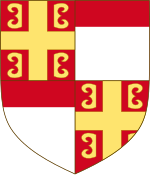| Palaeologus-Montferrat Palaiologos, Paleologo | |
|---|---|
 Arms of the family, combining the arms of the House of Aleramici with the tetragrammatic cross of the Byzantine Palaiologoi | |
| Parent house | Palaiologos (agnatic) Aleramici (cognatic) |
| Country | March of Montferrat |
| Founded | 1306 |
| Founder | Theodore Palaiologos |
| Final ruler | John George Palaeologus |
| Final head | Margaret Paleologa |
| Titles | Marquis of Montferrat |
| Traditions | Catholicism |
| Dissolution | 1566 |
| Deposition | 1533 |
The House of Palaeologus-Montferrat or Palaiologos-Montferrat, or just Palaeologus or Paleologo, was an Italian noble family and a cadet branch of the Palaiologos dynasty, the last ruling family of the Byzantine Empire. The cadet branch was created in 1306 when Theodore Palaiologos, fourth son of Byzantine Emperor Andronikos II Palaiologos, inherited the March of Montferrat through his mother, and Andronikos II's second wife, Yolande of Montferrat.
The Aleramici, Yolande's house and the previous rulers of Montferrat, had ruled the Kingdom of Thessalonica, a crusader state established around the city of Thessalonica after the Fourth Crusade in 1204. Though the resurgent Byzantines had reconquered Thessalonica in 1224, the Aleramici family still retained claims to the title. Because Andronikos II was eager to establish himself as legitimate in the eyes of Western Europe, he married Yolande in an effort to formally unite the claims of her family with his own de facto rule of Thessalonica, avoiding the potential future threat of a pretender launching an invasion against the empire.
At the time of their marriage, Yolande was second-in-line to the throne of Montferrat, and when her brother, John I of Montferrat, died without children in 1305, rulership of Montferrat legitimately passed to Yolande and her children, Theodore being chosen to make the journey to Italy and establish himself there. Many of the more conservative parts of the Byzantine aristocracy feared that Theodore and his descendants would become 'latinized'; fears that were realized once Theodore adopted Western customs and converted to Catholicism.
Although the Montferrat Palaiologoi continued to use typical Greek names, such as Theodore or Sophia, from time to time, and a handful of marquises had Byzantine aspirations, they tended to pay relatively little attention to events and affairs in the eastern Mediterranean. The imperial branch of the Palaiologos family were displaced in 1453 through the Fall of Constantinople, but the Montferrat cadet branch continued to rule Montferrat for almost another century after that, being replaced by the House of Gonzaga in 1533 after the death of the last male member of the house, John George Palaeologus. The last female member, Margaret Paleologa, died in 1566, rendering the house extinct. Their descendants are still alive today through matrilineal descent in several Italian noble houses, such as the House of Savoy.
